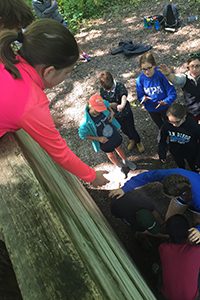August 29, 2018
 by Dr. Bill Hudson, Head of School
by Dr. Bill Hudson, Head of School
There was great excitement on a recent morning as I greeted students at the south entrance, particularly from eighth grade students. With sleeping bags, pillows, duffel bags, and suitcases in tow, our eighth graders prepared to depart for three days and two nights to Eagle Bluff, an environmental learning center in Lanesboro. I found myself chuckling as students looked like they packed for a three-month backpacking trip across Europe rather than several days in southern Minnesota!
The eighth grade trip has been an MPA staple for many, many years. It is a time to reconnect with friends, form new friendships, and grow as the “leaders” of the Middle School. At Eagle Bluff, the eighth graders will challenge themselves individually on the high ropes course and as a team through group challenges and GPS orienteering. Time to bond and reconnect over free time and everyone’s favorite camp activity—the bonfire and s’mores—make this the perfect beginning of their final year in Middle School. Similarly, sixth grade just returned from a trip to Audubon.
The ninth grade class spent time together at the State Fair for a scavenger hunt to foster relationship-building and class identity. In small groups determined by their advisory, new and returning students worked together to accomplish a series of tasks. Problem-solving, communication, and collaboration are critical skills students must employ to be successful. As new Upper School students, the day is symbolic of the independence they now enjoy and the accompanying responsibility of representing themselves and the school respectfully and positively.
This summer, I read an article published by the Harvard Graduate School of Education about school culture. The article emphasized that a positive and healthy school culture starts with connections—strong and overlapping interactions among all members of the school community.
“A culture will be strong or weak depending on the interactions between people in the organization. In a strong culture, there are many overlapping and cohesive interactions so that knowledge about the organization’s distinctive character—and what it takes to thrive in it—is widely spread,” it reads.
The article defines culture in light of five interwoven elements:
1. Fundamental beliefs and assumptions
2. Shared values
3. Norms
4. Patterns and behaviors
5. Tangible evidence
At MPA, we frequently describe the school community as a family. Implicitly and explicitly, our core beliefs and shared values are translated into norms of behavior expressed through patterns and actions. The results include traditions and experiences, such as the eighth grade Eagle Bluff trip, the sixth grade Audubon trip, and the ninth grade day at the Fair, that foster the connections essential to building a strong school culture. These are just three of the countless tangible manifestations of the incredible school culture that is intentionally strengthened and nurtured throughout the school year.